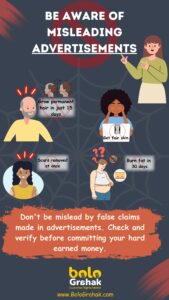Related Post

Grahak Rights and Sustainability; Promoting Environmentally Friendly Practices
Category: Blog






Advertisements reaching the common people through various mediums like print media, television, radio, digital media, event etc. Nowadays advertisement has taken over all aspects of one’s life. From bed-tea to beauty products, from household things to health drinks, companies are investing heavily money in the marketing of their products. An advertisement becomes misleading or false when suppose an advertisement of a water purifier that filters only bacteria (and not viruses) claims that it gives 100 percent safe water, then it is a false statement. Or if an advertisement for a face cream claims that it removes dark spots on the face and even prevents them from coming back, the manufacturer should be able to prove this. Or else, it is a deceptive advertisement. Remember, it’s not just a business but also a public service. So common people should be aware regarding the goods purchased. In recent times, online shopping has risen to heights where consumers are highly benefited and are equally fooled by various false products and misleading advertisements. It may contain statements or visual presentations, cinematic tricks which directly or by implication are likely to mislead the consumer, including claims purporting to be statements of fact.
One example is the advertisement of milk or various type of health drinks. Some companies claim that their products enhance performance during sports. Additionally, they use celebrities to endorse their products. Children usually take things at face value, and this misleads them into purchasing those items. Another example is the labelling of food as containing zero fat. This is also another gimmick. Apart from these, the advertisements regarding fairness creams, hair growth cream, getting slimmer or taller by popping pills, unrealistic high returns on low investments are the common examples of misleading advertisements.

Misleading advertising include:
If any consumer suffers any loss or damage as a direct consequence of such misleading advertisements, they can simply lodge their complaint on the portal created by the Union Ministry of Consumer Affairs. They can seek compensation from the manufacturer through the consumer courts constituted under the Consumer Protection Act. Apart from these, the Consumer Court can also direct the withdrawal of such advertisements. However, it is important to stay up to date with health alerts, safety alerts, product notifications, and recalls related to products that you use on a regular basis in order to minimise the risk of injury. Have you ever been misled by an advertisement or come across a false advertisement? Let us know by commenting here as we aim to promote a marketplace that priorities transparency, honesty, and consumer protection.
BOLO GRAHAK!!! CUSTOMER RIGHTS MATTER!
Source:(mondaq.com, ijalr.in, ccpc.ie, legalserviceindia.com)

Category: Blog





Your Comment